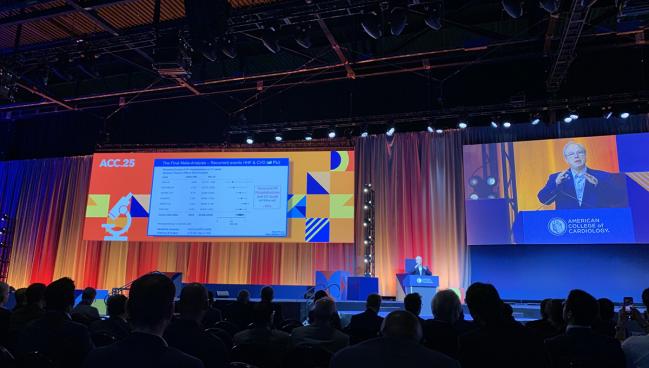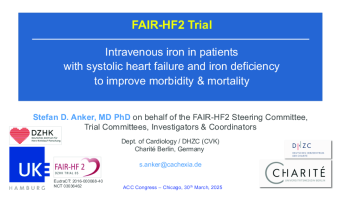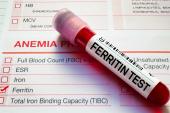FAIR-HF2: Another IV Iron Trial Fails to Impact Hard Endpoints
While inconsistent dosing could have played a role, it still may be possible to identify the patients most likely to see benefit.

CHICAGO, IL—Yet another trial of intravenous iron supplementation in chronic heart failure with reduced ejection fraction (HFrEF) has shown no significant impact in preventing patients from dying or heading to the hospital.
There was a trend in the newly reported FAIR-HF2 trial toward a reduction in the time to cardiovascular death or first heart failure hospitalization, which was one of three primary endpoints devised to account for data challenges during the COVID-19 pandemic. However, it missed statistical significance, as did two other primary endpoints.
“The results of the FAIR-HF2 are promising and are in line with previous results, but by themselves they are not significant in a strict statistical sense,” presenter Stefan D. Anker, MD, PhD (Deutsches Herzzentrum der Charité, Berlin, Germany), said here in a late-breaking trial session this week at the American College of Cardiology (ACC) 2025 Scientific Session.
There was an improvement in the mean patient-reported global assessment of well-being compared with placebo, supporting the overall belief among many HF specialists that treating iron deficiency improves quality of life (QoL).
“At the end of the day, we want our heart failure patients to feel better and be more functional, and I think your data supports that,” agreed Richard K. Cheng, MD (UW Medical Center, Seattle, WA), one of the panelists during the ACC session.
FAIR-HF2 joins IRONMAN, AFFIRM-AHF, and other trials that have tried—and failed—to show a meaningful benefit of IV iron supplementation on HF hospitalization and death in this population.
Anker believes the problem lies in the inconsistent dosing of ferric carboxymaltose. In the first year, the mean dose in the group randomized to iron supplementation was 2,040 mg, but it then dropped to 925 mg by the second year and to 750 mg by the third year.
“For the second primary endpoint, total heart failure hospitalizations—first and recurrent—you can see that [there is a] 20% reduction. I would like to highlight that within the first 12 months, the results were much stronger and much bigger in terms of magnitude,” he told TCTMD.
FAIR-HF2 Results
The trial enrolled 1,105 patients (mean age 70 years; 33% women) at 70 clinic sites in six countries in Europe. Baseline mean hemoglobin levels were 12.5 g/dL. Patients randomized to the iron group received an initial dose of 1,000 mg to 2,000 mg of ferric carboxymaltose, with the amount and timing dependent on body weight and baseline hemoglobin. This was followed by 500-mg doses of IV iron every 4 months for an average follow-up of 21 months. Placebo patients received IV saline on the same schedule.
The first primary outcome, CV death or first heart failure hospitalization, occurred in 16.7% of the iron supplementation group and 21.9% of the placebo group (P = 0.04). In his presentation, Anker said according to the methodology of the trial they would have had to achieve a P value < 0.02 to show significance, thus putting the 0.04 out of that range.
The second primary outcome, total HF hospitalizations, occurred in 26.4% and 33.4%, respectively (P = 0.12). The third primary endpoint, CV death or first HF hospitalization in the subset of patients with a transferrin saturation < 20%, occurred in 18.9% and 25.6%, respectively (P = 0.07).
Thirty-four percent of patients in the ferric carboxymaltose group and 38% of patients in the placebo group discontinued treatment during the trial.
On the 6-minute walk test, those on iron supplementation had a numerically but not statistically greater change in distance from baseline to 12 months than those on placebo (mean 27.2 vs 19.7 m; P = 0.08). There was a slight between-group difference from baseline to 12 months on the EuroQoL-5D patient-reported outcome measure. The patient-reported global assessment of well-being showed an improvement in the iron supplementation group compared with placebo (OR 0.25; 95% CI 0.17-0.37). Changes in New York Heart Association functional class, however, were similar in both groups.
In subgroup analysis, men were more likely than women to benefit from iron supplementation, a finding that Anker said requires more exploration.
The researchers also performed a meta-analysis of six RCTs comparing iron supplementation to placebo in 7,175 HF patients. The studies included FAIR-HF, FAIR-HF2, IRONMAN, CONFIRM-HF, AFFIRM-HF, and HEART-FID. For the endpoint of recurrent HF hospitalization or CV death with iron supplementation versus no supplementation in the first 12 months, there was a 28% reduction in favor of iron, providing support for Anker’s suggestion that the inconsistency of dosing beyond the first year may have impacted outcomes.
“This is something that we rarely see with other drugs, and then we then basically discontinue the treatment for various reasons and the [benefit] actually then just disappears,” Anker told TCTMD.
FAIR-HF2 was simultaneously published in JAMA, while the meta-analysis was simultaneously published in Nature Medicine.
Debating Definitions
Cheng noted that failed iron trials thus far have used traditional measures of either transferrin saturation or serum ferritin levels. He questioned whether newer indices, like hepcidin levels and soluble transferrin receptor (sTfR) index, might improve the identification of patients who would benefit from IV iron.
Nearly 70% of all patients in FAIR-HF2 had a transferrin saturation < 20%, which Anker believes is the best formal definition for trialists to use because it is a more specific marker of iron deficiency than those used previously.
In an ACC press conference with the media, Himabindu Vidula, MD (University of Pennsylvania, Philadelphia), said despite the disappointing results, FAIR-HF2 adds substantial data to the literature on the treatment of HFrEF patients with IV ferric carboxymaltose.
While the results support the potential use of transferrin saturation as a standalone criteria for diagnosing iron deficiency in patients with HF, “they also refute prior claims that patients with a transferrin saturation of less than 20% would experience a greater benefit,” Vidula added. “So, we still need to study this population more, but at least now we have another definition that could potentially be used in these patients.”
L.A. McKeown is a Senior Medical Journalist for TCTMD, the Section Editor of CV Team Forum, and Senior Medical…
Read Full BioSources
Anker SD, Friede T, Butler J, et al. Intravenous ferric carboxymaltose in heart failure with iron deficiency: the FAIR-HF2 DZHK05 randomized clinical trial. JAMA. 2025;Epub ahead of print.
Anker SD, Karakas M, Mentz RJ, et al. Systematic review and meta-analysis of intravenous iron therapy for patients with heart failure and iron deficiency. Nature Med. 2025;Epub ahead of print.
Disclosures
- Anker report research grants from Abbott Laboratories; and personal fees from Actimed Therapeutics, Alleviant, AstraZeneca, Bayer, Berlin Heals, BioVentrix, Boehringer Ingelheim, Brahms, Cardiac Dimensions, Cardior Pharmaceuticals GmbH, Cordio, CSL Vifor, CVRx, Cytokinetics, Edwards Lifesciences, Farraday Pharmaceuticals, GSK, HeartKinetics, Impulse Dynamics, Lilly, Mankind Pharma, Medtronic, Novartis, Novo Nordisk, Occlutech, Pfizer, Regeneron, Relaxera, Repairon GmbH, SCIRENT Clinical Research and Science, Sensible Medical, Servier, Vectorious Medical Technologies, Vivus, and V-Wave.






Comments